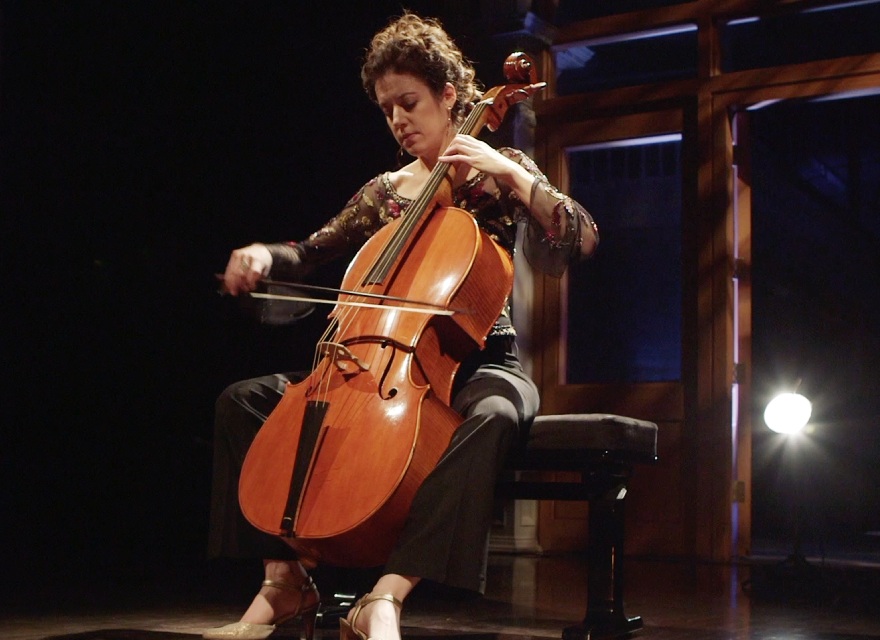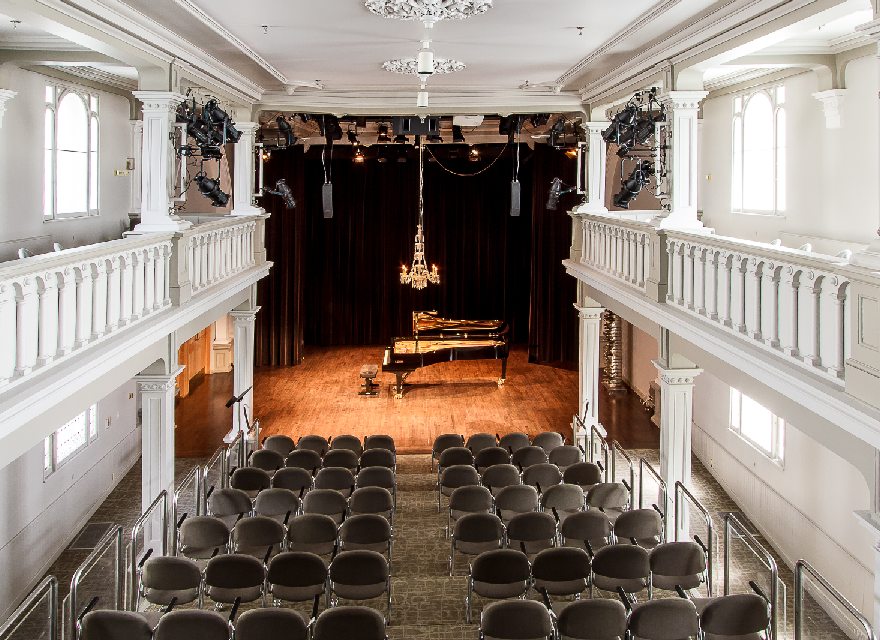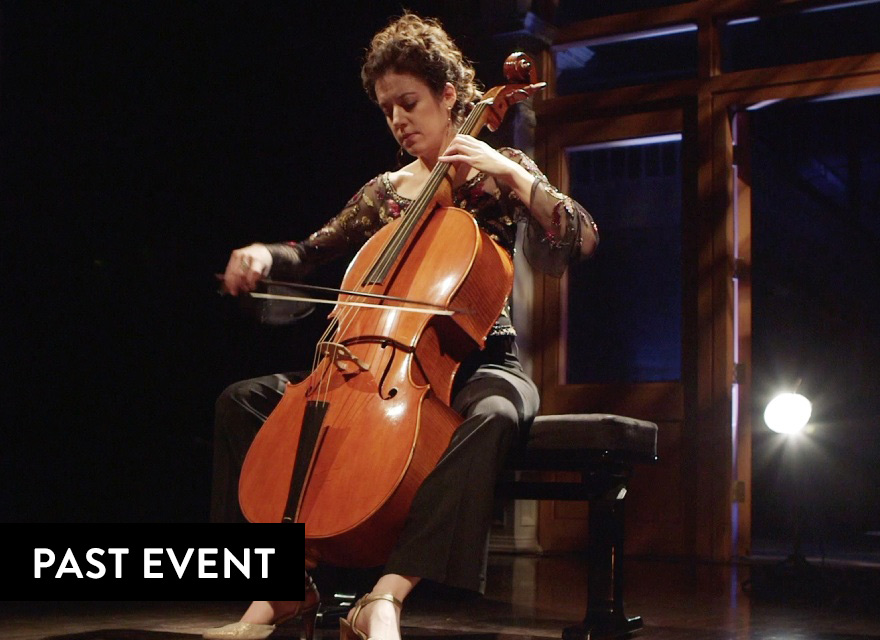CELLIST ELINOR FREY - BAROQUE PROGRAM
FREE ONLINE CONCERT – NO LONGER AVAILABLE
![]()
Elinor Frey, cello
Elinor Frey is a leading Canadian-American cellist and researcher who specializes in early music and new music. In addition to many recordings, Frey’s accomplishments include a US-Italy Fulbright Fellowship and the SSHRC Canada Graduate Scholarship facilitating her work on Italian cello music. In recent seasons she has performed with Il Gardellino, Constantinople, Clavecin en concert, Ensemble Caprice, and Les Idées heureuses, as well as with her quartet, Pallade Musica. Currently, an instructor at McGill University, and an instructor of Baroque cello at the University of Montréal, Frey holds degrees from Mannes, McGill, and Juilliard and is the Visiting Fellow in Music from 2019-2022 at Lady Margaret Hall, Oxford University. For this special solo recital, filmed in the beautiful Chapelle historique du Bon-Pasteur in Montréal, the cellist performs a stunning Baroque program featuring works by composers Francesco Paolo Supriani, Giuseppe Maria dall'Abaco, Giovanni Battista Vitali, Domenico Gabrielli, Giuseppe Colombi, Domenico Galli, Giulio Ruvo, and Johann Sebastian Bach.
PROGRAM
CLICK to open the Program Information in a separate window
Capriccio primo en do mineur Giuseppe (Joseph) dall’Abaco was the son of the Italian violinist and composer Evaristo dall'Abaco, who himself was the son of the famous guitarist Damiano dall'Abaco. Music, it seems, was in his genes. Joseph was born in Brussels which was at that time the capital of the Spanish Netherlands and received his musical training from his father. Through him, he absorbed the musical influences of Vivaldi and Corelli. Like his father, he became a court musician and composer. He was appointed music director of the court orchestra of the Prince-elector of Cologne at the age of 28. In 1753, he returned to Verona where he spent the rest of his life. Among his works are almost forty cello sonatas plus the 11 Capricci for Violincello Solo. Although he lived well into the classical era, most of his compositions were written in the Italian baroque style he learned from his father. Passa Galli Bergamasca Giovanni Battista Vitali spent his entire life in the Northeastern area of what is now Italy. Born in Bologna, his early career was taken up playing violone (a bowed string instrument, a precursor of the modern-day cello) in the orchestra of the San Pedrino Basilica in Bologna. He spent fifteen years in that position and published his earliest compositions there, mostly liturgical music, understandably. In 1674, Vitali became a musician at the Este court in Modena. Here, in this vibrant musical environment, he must have witnessed a greater diversity of musical styles and genres than he had been exposed to in Bologna and it is here that his compositional career flowered. While he wrote sacred vocal music and a series of pedagogical pieces designed to teach counterpoint, the bulk of Vitali’s output, and the music for which he is now best known, is courtly dance music. Ricercar no. 1 en sol mineur The life of Domenico Gabrielli is intertwined with that of Giovanni Vitali. He was born in Bologna roughly twenty years after Vitali, and like him, played in the orchestra of the Basilica of San Pedrino. In fact, when Vitali left to seek service with the Este Court in Modena, Gabrielli took his position as principal cello, the potential and importance of that instrument having become better established. During the 1680s, Gabrielli also played at the Este Court in Modena. He composed several operas, vocal and instrumental church music, and a quantity of music for solo cello. Among his compositions for cello is a set of seven Ricercari. A ricercar is a precursor of the fugue, and those of Gabrielli set the groundwork for later solo cello works, like the Bach Cello Suites. Ciaccona à Basso Solo (c. 1670) Like Vitali and Gabrielli, Giuseppe Colombi was employed at the Este Court in the 1670s and 1680s. A violinist and composer, he was assistant maestro di capella at the time Vitali arrived in 1674. He was also concertmaster at the cathedral in Modena from 1678 until his death in 1694. He composed sonatas and dance music as well as liturgical music. His Ciaccona was the inspiration for “Mystery Variations”, a suite of short pieces for solo cello by thirty different composers created early in the 21st century. These variations explore the potential of the instrument, using Colombi’s theme, as it is one of the earliest pieces written for the cello as a solo instrument. Suite no. 1 en sol majeur pour violoncelle seule, BWV 1007 Prélude Allemande Courante Sarabande Minuets I & II Gigue British musicologist and critic Wilfrid Mellers said of Bach’s Cello Suites, they are “monophonic music wherein a man has created a dance of God.” They are considered among the most profound musical compositions in Western culture and are among the most frequently played and most recognizable works for solo cello. They were composed between 1717 and 1723 during the years Bach served as Kapellmeister for Prince Leopold of Anholt-Cothen. Each suite begins with a prelude. The Prelude to Suite No. 1 is the most familiar movement in the whole set of six suites. This opening movement is then followed by a set of five dance movements; an allemande, a slightly more up-tempo courante, then a stately sarabande. For his fifth movement, Bach uses a pair of minuets in Suite No. 1, rather than the bourees or gavottes which we find in the other suites, and he concludes each suite with a gigue, the spriteliest and least courtly dance of the set. Sonate no. 5 en do mineur Dominico Galli was born in Padua and in addition to being a musician (yes, at the Este Court in Modena), he was a painter, sculptor, and instrument maker. Like his contemporaries at the Este court, G.B. Vitali and Giuseppe Colombi, he was himself a cellist. His only known music is Trattenimento musicale sopra il violoncello a’ solo, a set of 12 sonatas for solo cello. Precedents for his sonatas can be found in various works for solo cello by Colombi, and the Ricercary of Bolognese composer Domenico Gabrielli probably influenced him still more. Gabrielli had published his set of seven Ricercary in January 1689, shortly after spending a year at the Este court. The appearance of Galli’s sonatas in 1691 seems more than just coincidental: they could well have been inspired by his close contact with Gabrielli as the style of Galli’s Sonatas is remarkably close to that of Gabrielli. Romanella et Tarantella Much of what is known about Giulio Ruvo is deduced from the music he left behind. Like his contemporary, Francesco Supriani, he appears to have been a member of the Neapolitan school. His work bears the influence of Alessandro Scarlatti, one of the leading musicians of early 18th Century Naples, and he uses dance forms, like the romanella and tarantella, known to be popular in Naples at that time. In addition to his charming and elegant dance music, Ruvo wrote a number of cello sonatas. According to Grove Music, “The brilliant writing in these sonatas, technically adventurous for their time, reveals Ruvo’s familiarity with the cello, an instrument on which he was probably a virtuoso.” Toccata decima en mi mineur Francesco Paolo Supriani was an Italian cellist and composer of the Neapolitan school. He was born in the town of Conversano in southeastern Italy, near the Adriatic Coast. From 1693 Supriani studied at the "Conservatorio della Piéta dei Turchini”. In 1708 he was appointed first cello of the Real Capilla de Barcelona. He thus gained recognition as one of the early virtuosos on the cello. After two years of service in the Real Capilla, Supriani returned to Naples in 1710. There he shared music with some of the great musicians of the time, such as kapellmeister Alessandro Scarlatti. Supriani died in Naples in 1753. Among his works is a handwritten collection of twelve toccatas for solo cello which was rediscovered in the library of the "Conservatorio San Pietro a Majella" in Naples and published by the musicologist and cellist Luigi Silva (1903-1961). Tocattas originated in Northern Italy in the late Renaissance. Mostly written for the keyboard, they featured brilliant cascading passages against a chordal background. Supriani’s works that have survived are interesting due to the light they shed on the technical possibilities of an instrument which was, until that time, often limited to the basso continuo. He is also known for an explanatory text on the principles of playing the cello, an important source for understanding the state of musical education in 18th Century Italy.

ABOUT THE ARTIST
Elinor Frey, cello
Cellist Elinor Frey's acclaimed CDs on the Belgian label Passacaille – most of which are world premiere recordings – include La voce del violoncello (2013), Berlin Sonatas (2015) with Lorenzo Ghielmi on fortepiano, Fiorè (2017), which features soprano Suzie LeBlanc, and Giuseppe Clemente Dall’Abaco: Cello Sonatas (2020) which received a Diapason d’Or. She just released Antonio Vandini: Complete Works, a project in collaboration with Marc Vanscheeuwijck. Her critical edition of Dall’Abaco Sonatas is published in collaboration with Walhall Editions.
Frey’s debut album, Dialoghi, is titled for the solo piece written for her by Steven Stucky, and her CD of new works for Baroque cello, titled Guided By Voices, was released on the Analekta label in March 2019. These works are by Scott Godin, Linda Catlin Smith, Ken Ueno, Isaiah Ceccarelli, Maxime McKinley, and Lisa Streich.
Frey’s honours include a US-Italy Fulbright Fellowship, the SSHRC Canada Graduate Scholarship, American Musicological Society, and Canada Council for the Arts grants facilitating her work on Italian cello music. In recent seasons she has performed with Il Gardellino, Constantinople, Clavecin en concert, Ensemble Caprice, and Les Idées heureuses, as well as with her quartet, Pallade Musica, grand prize winners of the 2012 Early Music America Baroque Performance Competition and second prize winners in the 2014 International Van Wassenaer Competition in Utrecht. Currently, a course instructor at McGill University, and an instructor of Baroque cello at the University of Montréal, Frey holds degrees from Mannes, McGill, and Juilliard and is the Visiting Fellow in Music from 2019-2022 at Lady Margaret Hall, Oxford University. Frey was awarded Québec’s Opus Prize for “Performer of the Year” in 2021.

ABOUT THE VENUE
Chapelle historique du Bon-Pasteur
The Chapelle historique du Bon-Pasteur is a unique venue with exceptional acoustics. It's one of Montreal's most prestigious recital and chamber music halls. Every month, the Chapel holds a multidisciplinary or thematic exhibition related to the arts and music.
The Chapelle historique du Bon-Pasteur is located on the traditional territory of the Kanien’kehà:ka, a place which has long served as a site of meeting and exchange amongst many First Nations including the Kanien’kehá:ka of the Haudenosaunee Confederacy, Huron/Wendat, Abenaki, and Anishinaabeg. We recognize and respect the Kanien’kehà:ka as the traditional custodians of the lands and waters on which we recorded this performance.
We gratefully acknowledge the support of Arts Nova Scotia, the Nova Scotia Department of Communities, Culture, and Heritage, FACTOR, Sodec Québec, and Agence Station Bleue.


